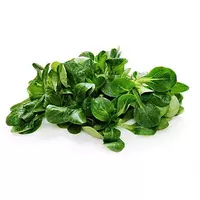Field salad

Valerianella spikelet or field salad (Valerianella locusta) belongs to plants from the genus Valerianella and the Valerian family. Field lettuce grows in European territory, and in addition in the temperate climate of Asian countries. In addition, field salad is found in northern Africa. This type of green salad is cultivated on an industrial scale in many regions of the planet Earth.
With the exception of the official scientific name Valerianella locusta, the field salad has several other names. The English-speaking population of the planet calls field salad cornsalad, in France the plant is called mâche, in Germany - Rapunzel, and in Spain - lechuga de campo. In its appearance and botanical structure, the field salad is an annual plant that belongs to the species of herbaceous crops.
As a rule, field salad shoots do not exceed 40 cm in height. The plant blooms between April and June in small white inflorescences, which are collected in dense semi-contics. Seeds of field salad are planted in open ground, without preliminary germination of the plant. Professionals claim that field lettuce can be planted at different times, since the plant has a short growing season.
However, the best result in the middle zone of the Russian Federation can be achieved when planting field lettuce in the ground in early spring. The field salad plant tolerates the heat quite poorly. It is also noteworthy that field salad can be planted in the autumn for the winter. However, it is necessary to cover the plant on the eyes of straw. Field salad for a fairly long time enjoys unprecedented popularity in Europe and the United States.
For residents of our latitudes, this type of green salad has not yet become "native. " However, an increasing number of gardeners and gardeners are growing the plant on their household plots. In cooking, young field salad leaves are used as well as other varieties of green salads. As a rule, field salad is used to prepare vitamin salads, the so-called mixes, which include various salad varieties.
Sometimes, field salad leaves are used to make first courses and sauces. Doctors and nutritionists advise people of all ages to eat green lettuce leaves as often as possible. Field salad helps with hypovitaminosis, and in addition, scientists have found evidence of the presence of sedative abilities of the plant.
Culinary professionals advise eating field salad leaves fresh. Moreover, it is worth seasoning the field salad with olive oil, this product helps to emphasize the taste of the field salad. In addition, field salad leaves are the perfect combination with chicory, as well as walnuts, apples and beetroot.
field salad 23 kCal
Energy value of field salad (Ratio of proteins, fats, carbohydrates - ju):
Proteins: 1.1 g (~ 4 kCal)
Fats: 0 g (~ 0 kCal)
Carbohydrates: 3.5 g (~ 14 kCal)
Energy ratio (b | y): 19% | 0% | 61%
 Español
Español Français
Français Português
Português Русский
Русский 简体中文
简体中文 繁體中文
繁體中文 日本語
日本語 한국어
한국어 العربية
العربية Türkçe
Türkçe Қазақ
Қазақ Deutsch
Deutsch Italiano
Italiano Українська
Українська
